NEC PA301w: The Baddest 30-inch Display Around
by Brian Klug on March 1, 2011 8:00 AM ESTViewing Angles
I almost don't need to say it, but the PA301w has superb viewing angles just as advertised. In both the horizontal and vertical directions, there's almost no distortion until viewed at the most extreme of angles. There's a bit more sensitivity in the vertical direction, but the difference is essentially insubstantial. Using the display in portrait is actually just an awesome testament to how good those viewing angles are - it's completely useable with no annoyances.
It's actually mind-blowing to use something this vertical to browse the net for even a few hours.
Color Quality
Next up are the ever-important color quality metrics. As usual, we report two main quality metrics: color accuracy (Delta-E) and color gamut. Color gamut refers to the range of colors the display is able to represent with respect to some color space. In this case, our reference is the AdobeRGB 1998 color space, which is larger than the sRGB color space. Our percentages are thus reported with respect to AdobeRGB 1998, and larger is generally better unless you're dealing with sRGB content and colorspace-unaware software.
Color accuracy (Delta E) refers to the display’s ability to display the correct color requested by the GPU and OS. The difference between the color represented by the display, and the color requested by the GPU is our Delta-E, and lower is better here. In practice, a Delta E under 1.0 is perfect - the chromatic sensitivity of the human eye is not great enough to distinguish a difference. Moving up, a Delta E of 2.0 or less is generally considered fit for use in a professional imaging environment - it isn’t perfect, but it’s hard to gauge the difference. Finally, Delta E of 4.0 and above is considered visible with the human eye. Of course, the big consideration here is frame of reference; unless you have another monitor or some print samples like a Gretag Macbeth color checker card to compare your display with, you might not notice.
As I mentioned in our earlier reviews, we’ve updated our display test bench. We’ve deprecated the Monaco Optix XR Pro colorimeter in favor of an Xrite i1D2 since there are no longer up-to-date drivers for modern platforms. We're trying to find an i1Pro to use as well.
For these tests, we calibrate the display and try to obtain the best Delta-E we can get at both 200 nits of brightness for normal use, and 100 nits for print brightness. We target D65 and a gamma of 2.2, but sometimes the best performance lies at native temperature and another gamma, so we try to find what absolute absolute best-case performance for each display. We also take an uncalibrated measurement to show performance out of the box using either the manufacturer supplied color profile, or a generic one with no LUT data. For all of these, dynamic contrast is disabled, and displays are left to settle for a half hour after making changes. The PA301w is CCFL-backlit, and I used a settle time of 30 minutes accordingly.
With the PA301w, I used the internal calibration routine to get me close, and then HCFR and the advanced OSD to get the color tristimulus primary values perfect. Then I calibrated with ColorEyes Display Pro.
First up is uncalibrated Delta-E performance. For this test, I took the monitor out of the box, connected it over DisplayPort, adjusted to 200 nits, and ran our usual GMB color checker test.
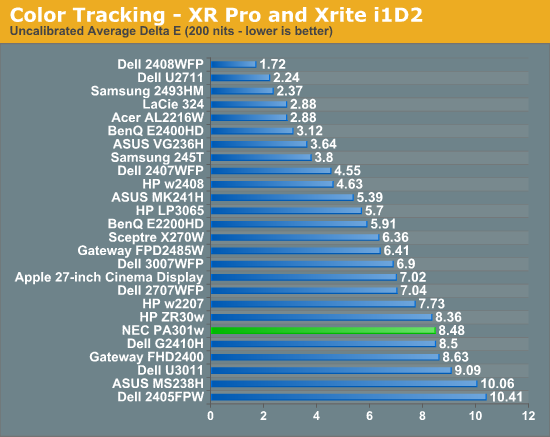
I took our uncalibrated test literally and ran this before using internal calibration either. Unsurprisingly, results aren't very good, and we see pretty middling performance out of the PA301w without any calibration. That said, if you're getting a professional monitor, you're hopefully going to calibrate it so you can actually enjoy what you're paying for. I didn't test, but running the in-monitor calibration alone has to help this out somewhat.
Moving on to the important 200 nit calibrated results, we can see the PA301w do very well, but still not displace the HP ZR30w result. I spent a lot of time trying to squeeze everything I could out of the PA301w and Delta E of 1.09 was as good as things would get. The result is still very good, I was just hoping to see something below 1.0 across the board like Jarred used to consistently. I'm beginning to suspect the i1D2 simply isn't as good of an instrument as the XR Pro, and what we're seeing is just instrumentational error creep in.
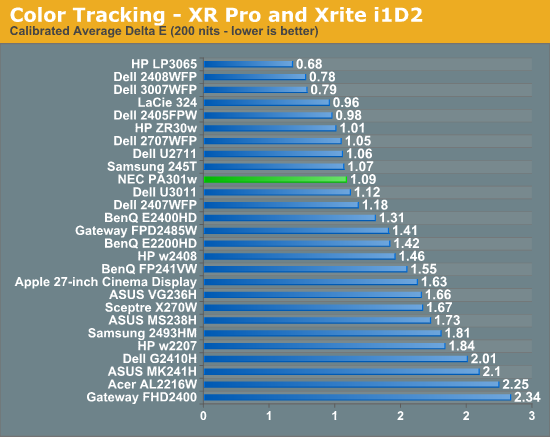
The PA301w doesn't have the typical spiky peaks that other displays which lack RGB controls show, which is great to see. You can see that the ZR30w still leads in some places, though the PA301w is clearly better in the greys.
At 100 nits, the PA301w pulls away and narrowly edges out the rest of the 30-inchers. Again, we still don't get a result that's under 1.0, but the numbers are obviously good enough for professional use.
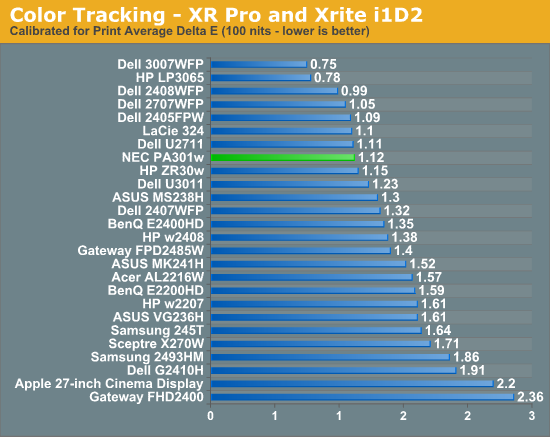
I'm impressed with color tracking on the PA301w and honestly think it can do better if we had an i1Pro spectroradiometer. I'm trying to get our hands on a good one, so we might just see it soon for these more serious display reviews.
Gamut percentage is important as well, and this is the only real place I think the U3011 has a distinct advantage. The PA301w has a "FULL" picture setting preset in the OSD which seems to change the red green and blue values to the edge of the display's supported gamut size. You can adjust further, however the labels turn pink which indicates that they're outside of the gamut. I went with full and took a reading, as expanding manually beyond didn't change the value any further. We can also see that the sRGB mode really clamps down on gamut percentage, and definitely works. There's also an AdobeRGB mode and a number of other common color spaces included. The PA301w uses an internal LUT to map color.
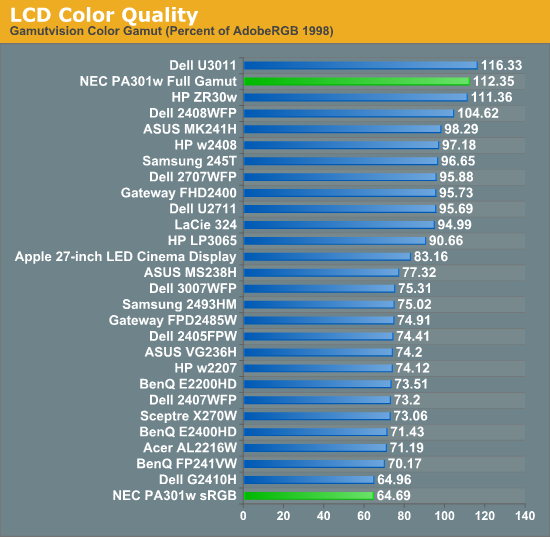









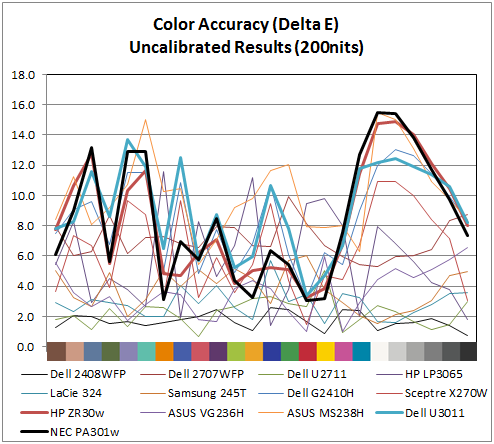
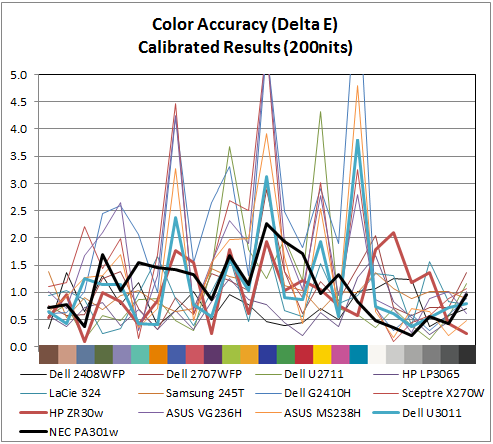









92 Comments
View All Comments
mbaroud - Tuesday, March 1, 2011 - link
When i saw the title, i thought, wow, this must be a really bad monitor.After reading the review, it looks like it is THE BEST with except of weight and dimensions.
Could you please change title, its misleading.
LTG - Tuesday, March 1, 2011 - link
It's an American coloquialism instantly recognized by most who lived there whole lives here.That said, there is a lot of word play in journalism I don't get and is a little frustrating when it happens to me so I understand your point.
Mumrik - Tuesday, March 1, 2011 - link
Ever heard of "The Baddest Man of the Planet"?This is a very normal way to put it. Nothing wrong with the title.
Zoomer - Friday, March 18, 2011 - link
Given the international audience anandtech serves, he has a point.Soulkeeper - Tuesday, March 1, 2011 - link
CCFL Backlight165 watts (typical)
41.5 lbs (18.8 kg)
2560 x 1600 at 60 Hz
Might as well just get a 21" CRT with those specs and price ...
Nentor - Tuesday, March 1, 2011 - link
I am sitting in front of a 21" CRT that I am still reluctant to pass on (Sony GDM F520) and those weigh around 35 kg / 77 lbs. It can only do 2048x max.DanNeely - Tuesday, March 1, 2011 - link
We had this discussion on one of the previous 30" monitor reviews. While LEDs backlights are lower power than CCFLs and have won most of the mobile market, and while LEDs can surpass the gamut and color accuracy of midrange CCFLs at an acceptable price premium and are winning the consumer display market, the best RGB LED backlights still cannot beat the gamut and color accuracy of the best CCFL backlights. Until that happens (or until consumer demand becomes large enough to sell a less capable low power model) displays aimed directly at the professional market will continue to use CCFL backlighting despite the higher power consumption.The final point I'd make is that the "typical" power consumption NEC lists is a worst case number. Depending on brightnesss Brian measured 58-136 watts, and like most modern LCDs the maximum brightness levels are too high to use comfortably outside of an exceptionally bright area (because otherwise they'd be too dim in places), so you won't be running it at maximum brightness unless you're working outside in the desert.
Breit - Tuesday, March 1, 2011 - link
Not exactly right i guess. Every now and then there are some good RGB LED monitors in the news (at least on paper)... e.g. the LaCie 730 (http://www.lacie.com/products/product.htm?pid=1109... I don't know for sure if its any good 'cause i only have a poor Dell U3011 on my desk, but who knows?! ;)AnnonymousCoward - Tuesday, March 1, 2011 - link
I'll pass going into detail about how insane you are.Griswold - Wednesday, March 2, 2011 - link
You should have passed the test for "Professional display equipment 101" instead.